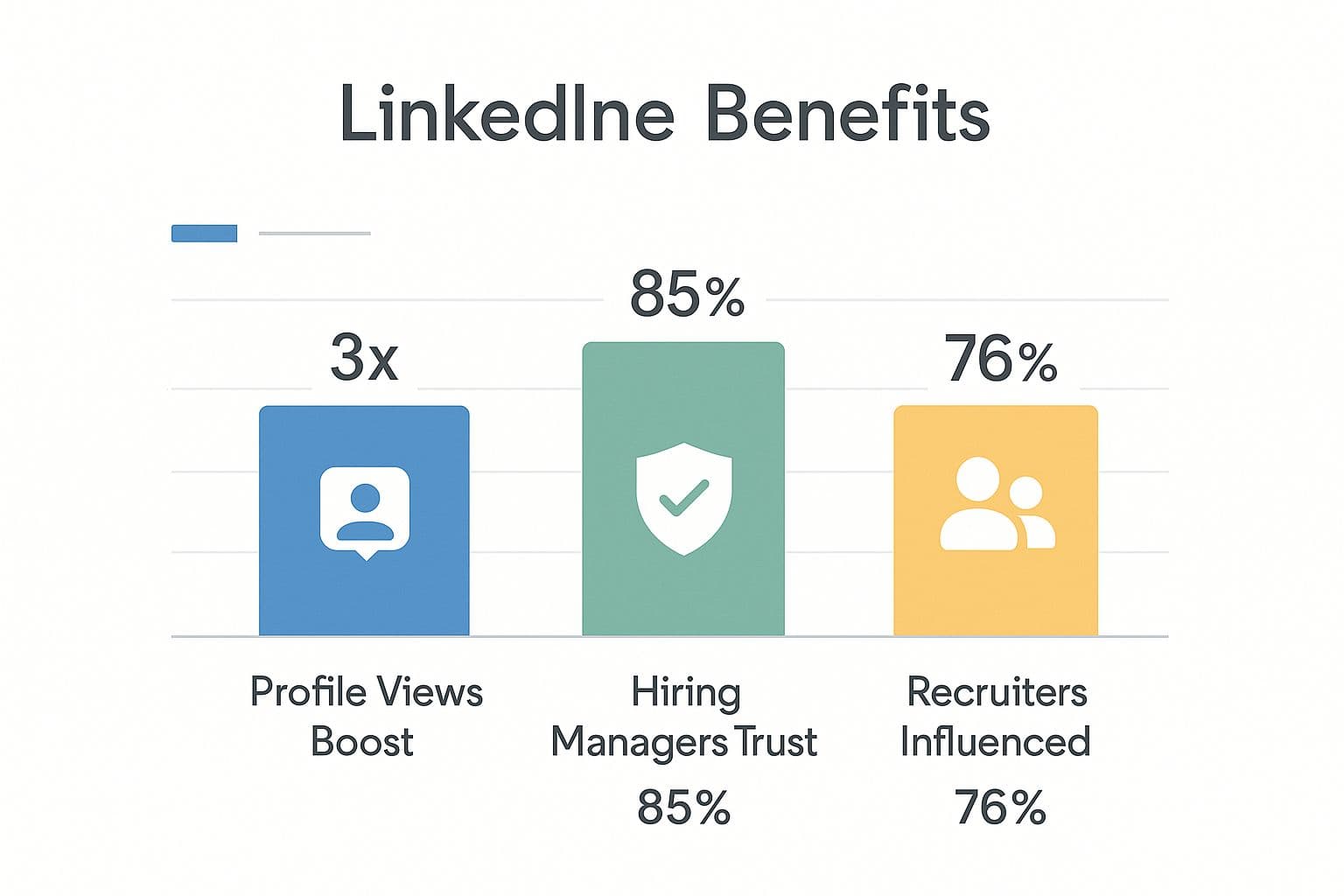Master Writing LinkedIn Recommendations that Stand Out
Learn expert tips for writing LinkedIn recommendations that get noticed. Boost your network with actionable advice today!

Writing a good LinkedIn recommendation is so much more than a simple favor. It’s a powerful way to build real social proof and make your professional relationships stronger. The trick is to skip the generic compliments and instead share specific, genuine stories that showcase what makes someone truly great at what they do. When you do that, it also makes you look like a credible and insightful professional.
Why Great LinkedIn Recommendations Matter
Let's be honest, writing a recommendation can feel like just another task on your to-do list. But what if it's actually one of the most powerful things you can do for your network? A truly thoughtful recommendation can be a game-changer, and overlooking its power is a huge missed opportunity for both you and your colleague.
Forget the tired old phrases like, "She was a pleasure to work with." We need to talk about the real-world impact these endorsements have on hiring decisions and how they create instant trust. Recruiters often value a peer's perspective even more than a formal reference list because it gives them an unfiltered, boots-on-the-ground look at a candidate.
The Anatomy of a Powerful LinkedIn Recommendation
So, what goes into a recommendation that actually gets noticed? It's not about writing an essay; it's about hitting the right notes with authenticity and specifics.
Here’s a breakdown of the core components that make a recommendation truly stand out.
| Component | What to Include | Why It Works |
|---|---|---|
| Hooking Introduction | Start with a strong, attention-grabbing opening sentence. | Immediately engages the reader and sets a positive tone for the rest of the recommendation. |
| Relationship Context | Briefly explain how you know the person (e.g., manager, peer, client). | Provides crucial context that establishes your credibility and the basis for your endorsement. |
| Specific Skills & Wins | Highlight 2-3 key skills with a specific example or accomplishment. | Vague praise is forgettable. Concrete examples provide tangible proof of their abilities and impact. |
| Standout Qualities | Mention a unique personal trait (e.g., problem-solving, team spirit). | This adds a human touch and shows what it's really like to work with them, going beyond just skills. |
| Strong Closing | End with a clear and enthusiastic final endorsement. | Leaves a lasting, positive impression and reinforces your confidence in their future success. |
Following this structure helps you create a narrative that is both compelling and easy for a busy hiring manager to digest.
The Power of Social Proof
A well-written recommendation is pure social proof. It's a third-party seal of approval on someone's skills, work ethic, and character, making their entire profile more believable and impressive. When a hiring manager sees detailed praise from a former boss or teammate, it carries serious weight.
This is especially true in today's crowded job market. The data consistently shows that profiles with strong, detailed recommendations simply get more eyeballs.
A strong recommendation serves as a public testament to someone's abilities. It's not just a nice gesture; it’s a strategic asset that can directly influence career opportunities and build a narrative of success around a professional.
The Data Doesn't Lie
This isn't just a feeling; the impact is backed by hard numbers. LinkedIn recommendations have a significant influence on hiring decisions. In fact, reports show that around 79% of recruiters see recommendations as a major factor in their hiring choices, and 70% of hiring managers trust them more than they trust traditional references. That shift alone shows how critical it is to get these right.
The infographic below really drives home how these endorsements affect profile visibility and recruiter trust.

As you can see, the benefits are crystal clear. Taking the time to write a great recommendation is a smart networking move with a real return. You're strategically supporting a colleague's career while simultaneously boosting your own professional credibility.
If you want to sharpen your professional writing even further, you can get more great advice from our guide on how to write professionally.
Your Pre-Writing Game Plan

Before you even think about writing, a little prep work goes a long way. This is what separates a generic, forgettable "they were great to work with" from a recommendation that actually tells a compelling story. A few minutes of planning up front will save you from the dreaded blinking cursor and help you write something that’s specific, genuine, and truly useful.
Think of it less as overthinking and more as being intentional. This small investment of time pays off, killing writer's block and leading to a much stronger, more impactful final recommendation.
Jog Your Memory for Specifics
Let's be real, your brain is a vault of great examples, but you need the key to unlock them. Don’t just go off a general feeling you have about the person. You need to dig up the concrete moments where they truly shined.
Here’s a simple trick I use to get the ball rolling:
- Dive into your digital archives. A quick scroll through old emails or a peek at past projects in Asana or Trello can be a goldmine. What challenges did you tackle together? How, specifically, did they help solve a problem?
- Check your calendar. Look back at meetings or events you both attended. Did they bring up a game-changing idea in a brainstorming session? Did they present something that shifted everyone's perspective?
- Creep their LinkedIn profile. Seriously. Reading through their own descriptions of projects and roles is a fantastic way to trigger your own memories of working with them on those exact things.
This isn't about being a detective; it's about finding those specific stories that showcase what makes them so good at what they do.
The most powerful recommendations are built on specific anecdotes, not vague praise. A story about how someone solved a single, tangible problem is worth more than a dozen generic compliments about their skills.
Make Sure It Aligns With Their Goals
A recommendation is only as good as it is relevant. Writing a rave review about someone’s incredible data analysis skills is kind, but it won’t do them much good if they're trying to pivot into a creative leadership role.
This is why, before I write a single word, I always ask a simple question: "What are your current career goals, and are there any specific skills or projects you'd like me to highlight?"
This isn't asking them to write it for you. It's about gathering the right ingredients. Their answer gives you a roadmap, ensuring your recommendation is perfectly positioned to help them get where they want to go. It’s a simple step that turns a nice gesture into a powerful, strategic asset for their career.
Weaving a Story Makes Your Recommendation Unforgettable

Let's be honest: a great recommendation is never just a laundry list of skills. It's a short, powerful story. The ones that really stick with you are those that skip the generic praise and give you a genuine feel for what a person brings to the table. When you frame your thoughts as a simple narrative, your recommendation suddenly has legs, offering solid proof of your colleague's talent.
This approach flips the script. Instead of it being a chore, writing a recommendation becomes a chance to genuinely champion someone you respect. It’s the difference between saying someone is a "great leader" and showing how they guided a team through a make-or-break project. The story is always more compelling.
Kick It Off With a Strong Opening Hook
Your first sentence needs to do some heavy lifting. It should grab the reader's attention and instantly set the scene. Forget the stiff formalities and get straight to the point. State your relationship to the person and your overall high regard for them. This gives you instant credibility.
Think of it as the opening shot of a movie. You’re establishing the "who" and "why" right away, so a busy recruiter or potential client immediately gets why your opinion matters.
- Weak Opening: "I am writing this recommendation for Jane Doe."
- Strong Opening: "Working alongside Jane for three years at a fast-paced startup, I was consistently amazed by her ability to stay calm and deliver results under pressure."
See the difference? The second one tells us how you know Jane, for how long, and the core quality that blew you away. It’s a much better way to pull someone in.
Show, Don't Just Tell, With a Specific Story
This is the real meat of your recommendation. Instead of dropping adjectives like "organized" or "creative," share a quick story that proves those qualities. Think back to a specific project, a tough challenge they navigated, or a moment where they were the absolute MVP.
This is what gives your words weight and makes them believable. It’s the concrete evidence hiring managers are desperate to find. A single, well-told story will always beat a paragraph of vague compliments.
The most impactful recommendations are built on specific evidence. A short story about how to turn a struggling project around or delight a difficult client provides undeniable proof of their competence and character.
Recounting a specific win paints a clear picture of how this person actually performs in the wild. For example, maybe you could describe how they streamlined a process that saved the team 10 hours a week. Or how their brilliant idea led directly to a 15% increase in customer engagement. Numbers talk.
Stick the Landing With a Confident Endorsement
Once you've shared your story, it's time to wrap it up with a clear, strong, and forward-looking statement. Your final sentence should leave zero doubt about your confidence in this person’s skills and future success.
Your closing is the final verdict, summing up your high praise. Make it enthusiastic and direct.
- Weak Closing: "I think she would be a good fit for many roles."
- Strong Closing: "Any team would be lucky to have Sarah's expertise and positive attitude; she will be a tremendous asset wherever she goes."
By the way, these principles of crafting powerful endorsements go way beyond LinkedIn. For more perspective on this, check out this excellent guide on writing effective testimonials. These skills are golden on any platform where social proof is king. And on a platform with over 1.1 billion members as of early 2025—with massive user bases in the US, India, and Brazil—your words have incredible reach.
Using AI as Your Productivity Partner
Let's be real: staring at a blank page is the worst. We’ve all been there. You want to write a fantastic recommendation for a great colleague, but the words just won't come. This is exactly where text-based AI tools can be your secret weapon, acting as a creative partner to get the ball rolling and boost your daily productivity.
This isn’t about having a robot write a fake, soulless endorsement. Far from it. It's about getting past that initial hurdle and being more efficient. You bring the genuine memories and specific examples; the AI helps you stitch them together into something polished and powerful, ensuring you gain a meaningful benefit from the technology.
Think of it as having a brainstorming partner on call 24/7. You can go from a blinking cursor to a solid first draft in seconds. This saves a ton of time and mental energy, letting you focus on making the final recommendation authentic and impactful.
Crafting the Perfect AI Prompt
The old saying "garbage in, garbage out" has never been more true than with AI. To be more productive with AI, you need to provide specific, high-quality inputs. If you give a vague instruction, you'll get a bland, generic result. To get something that actually sounds like you and provides a meaningful benefit, you need to feed the AI details about the person and your time working together.
Your prompt needs to be more like a detailed creative brief. Make sure you include these key ingredients:
- Your relationship: "I was Sarah's direct manager for three years at Acme Inc."
- Their top skills: "She’s an absolute wizard at project management and is one of the best communicators I've ever worked with."
- A specific story: "She completely saved the 'Phoenix Project.' It was behind schedule, but she jumped in, created a new workflow in Asana, and her daily stand-ups got everyone aligned. We launched two weeks early because of her."
- Their personality: "On top of that, she has an incredibly positive attitude and is a natural mentor to the junior developers."
- The tone you're going for: "I want the tone to be professional but also warm and genuinely enthusiastic."
This level of detail gives the AI the rich, raw material it needs to generate a draft that feels personal and real. An AI-powered writing assistant can be a huge help here, especially for saving and tweaking prompts you use often in your daily life.
Pro-Tip: Don't just ask the AI to "write a recommendation." Be specific and take command. Try something like: "Act as a marketing director writing a LinkedIn recommendation for a former direct report. Write a 120-word recommendation for Sarah based on these points..." That specificity makes all the difference in getting productive, quality results.
From First Draft to Final Polish
Once you have that AI-generated draft, the real work begins. But don't worry—it’s much easier than starting from scratch. Now, your job is to be the editor, refining the text so it sounds less like a machine and more like you.
You can actually use AI text generator tools for this editing phase, too. This is a great tip for using AI productively in your daily text-based tasks:
- Do a tone check: Paste your draft and ask, "Does this sound authentic and warm, or is it too stiff and formal?" This is a great way to make sure your personality comes through.
- Shorten and sharpen it: If your draft feels a bit long-winded, you can prompt it with, "Make this more concise but keep the key achievements." It’s surprisingly good at cutting the fluff.
- Punch up the ending: Try asking it to "make the final sentence stronger and more memorable." This is perfect for crafting a powerful closing line that sticks with the reader.
At the end of the day, you are the final editor. Always read the recommendation out loud—it’s the fastest way to catch clunky phrasing. Tweak words and rearrange sentences until it sounds like something you’d actually say. The AI can get you 90% of the way there, but that final 10% of human touch is what makes a recommendation truly genuine and provides meaningful value.
How to Write for Different People in Your Network

Think about it—you wouldn't talk to your boss the same way you'd chat with a junior team member you're mentoring. That same idea applies directly to writing LinkedIn recommendations. The best ones are always tweaked for the specific relationship you had with that person.
Nailing these little differences is everything. A generic, one-size-fits-all recommendation feels lazy and just doesn't hit the mark. When you adjust your message, it feels more genuine and provides the kind of real-world proof that can actually help someone land their next big opportunity.
On a platform where your career is constantly on display, this stuff matters. LinkedIn is a massive professional hub, with over 1.1 billion users globally, and the 25-34 age group is the largest slice of that pie. A sharp, well-written recommendation can give someone a serious edge. You can find more details in these LinkedIn user statistics from columncontent.com.
Writing for a Direct Report or Mentee
When you’re recommending someone you managed or mentored, your goal is to showcase their growth and potential. You have a unique perspective on their development, so use it!
Focus on the story of how they evolved while working with you. Did they grab a tough project by the horns and exceed all expectations? Did you see a real hunger in them to learn new skills and immediately put them into practice?
- What to spotlight: Zero in on their coachability, their drive to take on more responsibility, and specific moments where they blew your expectations out of the water.
- For example: "From the day I hired Alex, I was struck by his initiative. He didn't just do his job well; he was always looking for ways to make our team's process better. He ended up leading a project that boosted our efficiency by 20%. His potential is off the charts."
Writing for a Peer or Colleague
For a peer, the secret ingredient is collaboration. Your recommendation should paint a clear picture of what it's like to be in the trenches with them every day.
How did they make the team better? Were they the go-to person you could count on when a deadline was looming? Talk about their reliability and how they approached teamwork. This kind of praise is gold because it comes from someone who was right there beside them.
When you're writing for a peer, think about what made them an awesome teammate. A hiring manager reading it wants to know, "Does this person make the people around them better?" Your story can answer that question.
If you need a little more inspiration, you might find our guide on picking the perfect template for recommendations helpful. You can easily adapt them for any situation.
Writing for a Manager or Leader
Endorsing a former manager is a bit different. Here, you want to focus on their leadership, mentorship, and the positive impact they had on you and the rest of the team. It's a great way to show genuine appreciation for their guidance.
Think about how their leadership style created a great work environment. Did they empower you to do your best work? Did they shield the team from office politics or unnecessary red tape?
- What to spotlight: Highlight their communication skills, their ability to mentor others, and their strategic vision for the team.
- For example: "Maria was more than a manager; she was a true mentor. Her clear vision for our department and her knack for giving feedback that was both constructive and actionable helped me grow immensely. Any team would be lucky to have her leading them."
Got Awkward Questions About Recommendations? I’ve Got Answers.
Writing a LinkedIn recommendation can sometimes feel… weird. You want to help, but you might be stumped on what to say or how to handle certain situations. Let’s tackle some of the most common questions head-on so you can write with confidence.
First up, length. People tend to overthink this one. Honestly, the sweet spot is usually around 4-7 sentences. That’s roughly 100-150 words. It’s just enough space to tell a quick, meaningful story without your reader’s eyes glazing over. A short, punchy recommendation always beats a long, rambling one.
"What If I Can't Remember a Specific Project?"
It happens to all of us. You know the person is great, but a single project isn't jumping out at you. No worries. Instead of focusing on one event, talk about their consistent qualities.
Think about what they were like to work with day-in and day-out. What was their signature move? This kind of insight is just as powerful because it speaks to their character and how they show up every day.
For example, you could write something like: "I could always count on Sarah in our team meetings. She had this incredible knack for staying calm under pressure and always found a way forward, no matter what curveballs were thrown our way." See? No project name needed, but it paints a clear, valuable picture.
"Is It Weird to Ask Them What to Write?"
Ah, the classic dilemma. Asking someone, "Hey, can you just write it for me and I'll post it?" is definitely awkward and feels disingenuous. It puts both of you in a strange position.
But asking for a little guidance? That’s not weird—it's smart.
A much better way to handle it is to say something like, "I'd love to write you a recommendation! To make sure it's as helpful as possible, could you send me a few bullet points on the projects you're most proud of or the skills you'd like me to emphasize?"
This gives you authentic material to work with, allowing you to craft an honest recommendation in your own voice.
Here's a pro-tip for the modern age: Use those bullet points as a prompt for an AI tool. This is a perfect example of using AI for productivity in daily life. You can feed their highlights into your favorite AI writer and ask it to draft a recommendation. It’s a fantastic way to beat writer’s block and get a solid first draft.
This hybrid approach is the best of both worlds. You get a personalized, impactful recommendation that’s genuinely helpful for their career goals, but you don't have to stare at a blank screen. It’s all about working smarter, not harder, while keeping your endorsement authentic and ensuring the final text provides a meaningful benefit.
TypeBoost helps you stop switching tabs by putting your favorite AI prompts right where you need them. Instantly fix grammar, rewrite text, or turn voice notes into polished content in any app on your Mac. Learn more about TypeBoost and start your free trial.